View in other NatureServe Network Field Guides
NatureServe
Montana
Utah
Wyoming
Idaho
Wisconsin
British Columbia
South Carolina
Yukon
California
New York
Yellowflag Iris - Iris pseudacorus
Other Names:
Yellow Iris, Pale Yellow Iris, Pale-yellow Iris
State Rank Reason (see State Rank above)
In Montana, Yellowflag Iris was first collected in 1957 in Lake County though not identified until 1959. Since 2002, the Montana Department of Agriculture has listed it as a noxious weed (MDA 2017). In North America this plant was intentionally transplanted as an ornamental and has escaped cultivation. In Montana it was planted by an iris gardener in 1925 in Ronan, and unintentionally escaped (Preece 1964). By 1959 significant populations were established in the Ninepines vicinity of the Mission Valley in northwest Montana (Preece 1964). Populations form large, dense monotypic stands, outcompeting other plants (Ramey and Peichel 2001). A conservation status rank is not applicable (SNA) because exotic plants are not a suitable target for conservation activities.
General Description
PLANTS: Herbaceous perennials that grow from 1 to 1.5 meters tall with showy flowers and thick rhizomes (DiTomaso and Healy 2003). Stems are clumped (Lesica 2012). Rhizomes are up to 5 inches wide, have black sap, and produce roots that range from 4 to 12 inches long (Jacobs et al. 2011).
LEAVES: Each plant has up to several equitant leaves that fold in half length-wise and enclose the base of the next higher leaf (Jacobs et al. 2011; Lesica 2012). Thus, leaves emerge from the ground resembling a spreading fan (Jacobs et al. 2011). Each leaf resembles a sword’s tip, and is from 50-100 cm (20-40 inches) tall and 10-30 cm (0.4-1.2 inches) wide.
INFLORESCENCE: An erect raceme of 3-10 yellow flowers, that branches in its upper portion (Lesica 2012). Bracts (spathes) are leaf-like, 4-7 cm long, and enfold the stem; the outer are keeled (Lesica 2012).
The genus name “Iris” is derived from Iris, the greek goddess of the rainbow and messenger to the gods (Ramey and Peichel 2001). The specific epithet name “pseudacorus” means false (pseud) sweet flag (Acorus) referring to the similarity with the genus Acorus (Ramey and Peichel 2001).
Phenology
Flowers bloom from May to July, and are pollinated by insects. Seeds are produced between July and October. Germination primarily occurs the following spring.
Diagnostic Characteristics
Montana has two
Iris species:
Rocky Mountain Iris (
Iris missouriensis) and Yellowflag. The native Rocky Mountain Iris has a similar appearance, but develops 1-3 blue flowers and Yellowflag Iris has 3-10 yellow flowers. Both iris species occupy similar habitats. Rocky Mountain Iris grows in moist to wet meadows and irrigation ditches, but can tolerate drier conditions (thickets and woodlands). Yellowflag Iris requires moist to wetter habitats. In addition, Rocky Mountain Iris plants tend to be shorter (10-50 cm), have shorter (10-40 cm) and narrower (3-8 mm) leaves, and their rhizomes lack the black sap (Jacobs et al. 2011; Lesica 2012).
Cattail (
Typha latifolia and
T. angustifolia) leaves sheath at the base and appear similar when young, but their stems are round (not flattened).
Species Range
Montana Range
Range Descriptions
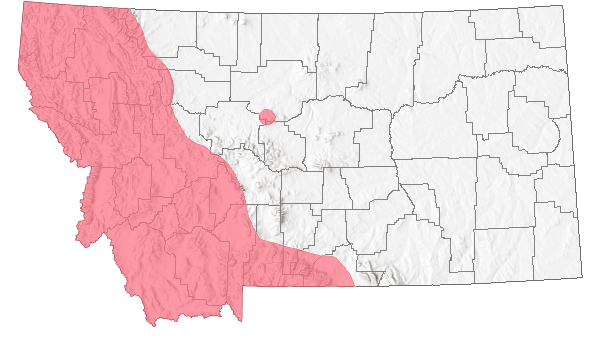
 Non-native
Non-native
Range Comments
Yellowflag Iris is native to Europe, the British Isles, North Africa and the Mediterranean region (Cody 1961), and introduced throughout temperate North America (Lesica 2012). Yellowflag Iris was brought to Canada and the U.S. as an ornamental plant (Ramey and Peichel 2001). It was first collected in the wild in Newfoundland, Canada in 1911 (Ramey and Peichel 2001). In the USA it was first documented in 1771 in Virginia (Jacobs et al. 2011). It was planted in Ronan, Montana in 1925 by an iris gardener. The first Montana herbarium specimen was collected in 1957 and by 1959, large populations were found in vicninity of the Ninepipes National Wildlife Refuge (Preece 1964). It is now found in western Montana (Jacobs et al. 2011).
For maps and other distributional information on non-native species see:
Nonindigenous Aquatic Species Database from the U.S. Geological Survey
Invasive Species Habitat Tool (INHABIT) from the U.S. Geological Survey
Invasive Species Compendium from the Centre for Agriculture and Bioscience International (CABI)
EDDMapS Species Information EDDMapS Species Information
Observations in Montana Natural Heritage Program Database
Number of Observations: 11467
(Click on the following maps and charts to see full sized version)
Map Help and Descriptions
Relative Density
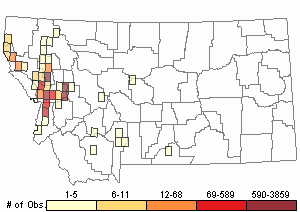
Recency
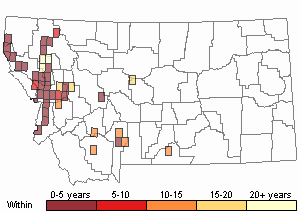
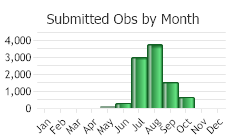
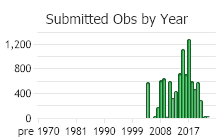
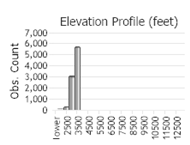 (Observations spanning multiple months or years are excluded from time charts)
(Observations spanning multiple months or years are excluded from time charts)
Habitat
Disturbed wetland habitats: marshes, wet meadows, irrigation ditches, pond margins, and riparian areas in the valleys (Lesica 2012).
Ecology
Yellowflag Iris grows in temperate climates in habitats associated with water from sea level to 4300 feet in elevation (Tu 2003). It typically grows in shallow waters, but can tolerate depths of 2-3 feet (Tu 2003). It typically grows in moist to saturated silt, sand, gravel, or cobble substrates associated with calcareous, sandy loam, clay loam, or peat soils (Jacobs et al. 2011). It can grow where soils are seasonally dry. Soils can range in pH from 3.6 to 7.7 (Tu 2003). It requires soils that are high in nitrogen, but can tolerate high percentages of organics and low levels of oxygen (Tu 2003). It can tolerate long periods of anoxic soil conditions (no free oxygen and reducing conditions) (Tu 2003). It can grow in salt marshes and tolerate salinity levels 24 percent (Tu 2003).
Yellowflag Iris does not provide food for native animals and it contains glycosides which are poisonous to grazing animals (Tu 2003). All parts of the plant are poisonous (Tu 2003). Birds do not ingest or disperse the seeds (Tu 2003).
POLLINATORS The following animal species have been reported as pollinators of this plant species or its genus where their geographic ranges overlap:
Bombus appositus,
Bombus auricomus,
Bombus bifarius,
Bombus centralis,
Bombus fervidus,
Bombus flavifrons,
Bombus huntii,
Bombus melanopygus,
Bombus nevadensis,
Bombus rufocinctus,
Bombus occidentalis,
Bombus pensylvanicus,
Bombus griseocollis,
Bombus insularis, and
Bombus suckleyi (Macior 1974, Heinrich 1976, Thorp et al. 1983, Colla and Dumesh 2010, Miller-Struttmann and Galen 2014).
Reproductive Characteristics
Each flower has 3 downward-pointing sepals and 3 upward-pointing petals that look similar and are joined at their bases, 3 stamens united at their bases, and an inferior ovary with a 3-branched style (Jacobs et al. 2011; Lesica 2012). Sepals and petals range from light to dark yellow. Sepals often have brown veins or flecks, an orange spot near the base, and lack dense hairs (not bearded) on the upper surface (DiTomaso and Healy 2003). The stamens are hidden beneath the fringed, style branches (Jacobs et al. 2011). Flower pedicels are 2–4 cm long (Lesica 2012).
Plants reproduce by seeds and by rhizomes. Flowers are pollinated by bumble bees (Bombus spp.) and long-tongued flies (Tu 2003). The fruits are 3-sided, obovoid, 3-7 cm long capsules (or pods) (Lesica 2012). Each capsule contains three chambers with two rows of roundish, flat, brown seeds (Jacobs et al. 2011). Each capsule produces about 6 to 120 seeds, but many remain undeveloped and not viable (Jacobs et al. 2011). Seeds contain air in their seed coats allowing them to float for long periods and be dispersed by water (Jacobs et al. 2011).
The seasonal accumulation of carbohydrates creates annual segments in the rhizomes that can be counted to determine the plant’s age (Jacobs et al. 2011). Air chambers in the rhizomes facilitate survival under conditions of low-oxygen, such as when soils are saturated for a prolonged duration (Jacobs et al. 2011). One study found that excavated rhizomes grew for 3-months indoors without water, indicating they can tolerate drought (Jacobs et al. 2011). Rhizomes and leaves contain glycosides that deter herbivory (Jacobs et al. 2011). Fragmented rhizomes can form floating mats (Jacobs et al. 2011).
LIFE CYCLE [Adapted from Jacobs et al. 2011].
Flowers bloom from May to July and seeds develop from July to October. Most seeds germinate the following spring, but some germinate in summer and very few in fall. Germination occurs on moist, drained soil, and not when fully inundated (Tu 2003). The germination rate of freshly collected seeds was found to be 48 percent at 40 degrees Fahrenheit (5 degrees Celsius). This rate increased if seeds were scarified, and further increased with removal of the fat-like seed coating.
Under normal germination conditions, a root emerges from the seed and grows for about five days. The shoot emerges on the seventh day and cotyledons appear on the tenth day. After one month seedlings can have three leaves, lateral roots, and adventitious roots. The proportion of roots to shoots in seedlings is high, and may help it establish in muddy substrates.
Dispersal primarily occurs by seeds, and less frequently by fragmented rhizomes.
Management
Montana's Yellowflag Iris Task Force is led by Jed Little who can be contacted at: (406) 258-4220 or
mapping@missoulaeduplace.org Yellowflag Iris was introduced to North America as a horticultural plant. Many cultivars of this species have been developed (Tu 2003). Because of its growth form, Yellowflag Iris has been planted for erosion control and in sewage treatment ponds (Tu 2003). It has been used to collect sediment and to remove copper and iron heavy metals from wastewater (Tu 2003).
PREVENTIONIt is a beautiful plant that will continue to be spread by gardeners, garden dealers, and sales on the internet until the sale of the species is banned. Preventing new infestations is the best means for controlling the plant. It is difficult to eradicate because it reproduces vegetatively and by seed, is adaptable to a wide range of moisture and soil conditions, and has few pests or predators (Tu 2003).
CHEMICAL CONTROL [Adapted from Tu 2003.]
Herbicides are effective at controlling populations. However, the type of herbicide, herbicide concentration, timing of chemical control, and other factors will determine its effectiveness. Always wear protective clothing designed for chemicals, follow chemical label instructions, and use restrictions. Many herbicides must be applied by applicators with an Aquatic Pest Control license. Consult your County Extension Agent and/or Weed District for more information on herbicidal control.
Because it grows in or adjacent to water, an aquatic-labelled herbicide and adjuvant must be used. Glyphosate, under the trade names of Rodeo®, Aquamaster® or Glypro®, has been used successfully to kill Yellowflag Iris; however, plants are resistant to Terbutryne. Use Glyphosate in a 25 percent solution (13 percent a.i.) with a dripless wick/wiper applicator, or spray it using a 5-8 percent solution, and in combination with the appropriate non-ionic surfactant adjuvant. It is recommended to use a dye to better track sprays. The herbicide can be applied directly to leaves or to freshly cut leaves/stems. Spot-treat plants and do not broadcast spray in order to protect other native plants, animals, and water quality.
MECHANICAL CONTROL [Adapted from Tu 2003.]
Mechanical control is labor-intensive, but new or small patches can be controlled by physically removing the entire plant. It is essential to remove the entire rhizome, since small pieces of rhizome can re-sprout. Protective gear should be worn since resinous substances in the leaves and rhizomes can irritate the skin.
Mowing can provide control if done annually, but it will not remove the plant. Likewise, removing the flowers/fruits (dead-heading) will reduce its ability to spread, but will not kill the plant. Plants are poisonous if ingested by grazing animals.
BIOLOGICAL CONTROL [Adapted from Tu 2003.]
There are no known biological controls available for Yellowflag Iris. Many invertebrates and fungi do feed upon iris, and specific species are listed in the document, Element Stewardship Abstract for Iris pseudacorus L. by Mandy Tu of The Nature Conservancy (2003). In addition, the iris root rot called Pseudomonas iridis causes leaves to yellow and rhizomes to rot. However, none of these insects, fungi, or pathogen significantly kill plants or control populations.
CULTURAL [Adapted from Tu 2003.]
Prescribed fire is not recommended for controlling Yellowflag Iris. Plants grow in wet environments which are often poorly affected by fire and where other native plants are not adapted to fire. Rhizomes can re-sprout in response to low-severity fires.
Contact information for local county Weed District Coordinators can be found on the
Montana Weed Control Association Contacts WebpageContact information for Aquatic Invasive Species personnel:Montana Fish, Wildlife, and Parks Aquatic Invasive Species staffMontana Department of Natural Resources and Conservation's Aquatic Invasive Species Grant ProgramMontana Invasive Species Council (MISC)Upper Columbia Conservation Commission (UC3)Stewardship Responsibility
References
- Literature Cited AboveLegend:
 View Online Publication
View Online Publication Colla, S.R. and S. Dumesh. 2010. The bumble bees of southern Ontario: notes on natural history and distribution. Journal of the Entomological Society of Ontario 141:39-68.
Colla, S.R. and S. Dumesh. 2010. The bumble bees of southern Ontario: notes on natural history and distribution. Journal of the Entomological Society of Ontario 141:39-68. Lesica, P., M.T. Lavin, and P.F. Stickney. 2012. Manual of Montana Vascular Plants. Fort Worth, TX: BRIT Press. viii + 771 p.
Lesica, P., M.T. Lavin, and P.F. Stickney. 2012. Manual of Montana Vascular Plants. Fort Worth, TX: BRIT Press. viii + 771 p. Macior, L.M. 1974. Pollination ecology of the Front Range of the Colorado Rocky Mountains. Melanderia 15: 1-59.
Macior, L.M. 1974. Pollination ecology of the Front Range of the Colorado Rocky Mountains. Melanderia 15: 1-59. Miller-Struttmann, N.E. and C. Galen. 2014. High-altitude multi-taskers: bumble bee food plant use broadens along an altitudinal productivity gradient. Oecologia 176:1033-1045.
Miller-Struttmann, N.E. and C. Galen. 2014. High-altitude multi-taskers: bumble bee food plant use broadens along an altitudinal productivity gradient. Oecologia 176:1033-1045. Thorp, R.W., D.S. Horning, and L.L. Dunning. 1983. Bumble bees and cuckoo bumble bees of California (Hymenoptera: Apidae). Bulletin of the California Insect Survey 23:1-79.
Thorp, R.W., D.S. Horning, and L.L. Dunning. 1983. Bumble bees and cuckoo bumble bees of California (Hymenoptera: Apidae). Bulletin of the California Insect Survey 23:1-79.
- Additional ReferencesLegend:
 View Online Publication
View Online Publication
Do you know of a citation we're missing? Lesica, P., M.T. Lavin, and P.F. Stickney. 2022. Manual of Montana Vascular Plants, Second Edition. Fort Worth, TX: BRIT Press. viii + 779 p.
Lesica, P., M.T. Lavin, and P.F. Stickney. 2022. Manual of Montana Vascular Plants, Second Edition. Fort Worth, TX: BRIT Press. viii + 779 p. Montana Department of Agriculture (MDA). 2017. Montana Noxious Weed List. February. Helena, Montana.
Montana Department of Agriculture (MDA). 2017. Montana Noxious Weed List. February. Helena, Montana. Preece, S.J. 1964. Iris pseudacorus in Montana. Proceedings of the Montana Academy of Sciences. 24:1-4.
Preece, S.J. 1964. Iris pseudacorus in Montana. Proceedings of the Montana Academy of Sciences. 24:1-4. Ramey, V. and B. Peichel. 2001. Non-Native Invasive Aquatic Plants in the United States: Iris pseudacorus. Center for Aquatic and Invasive Plants, University of Florida and Sea Grant, University of Minnesota.
Ramey, V. and B. Peichel. 2001. Non-Native Invasive Aquatic Plants in the United States: Iris pseudacorus. Center for Aquatic and Invasive Plants, University of Florida and Sea Grant, University of Minnesota. Raven P.H. and J.H. Thomas. 1970. Iris pseudacorus in western North America. Madrona. V. 20, N. 8, 390-391.
Raven P.H. and J.H. Thomas. 1970. Iris pseudacorus in western North America. Madrona. V. 20, N. 8, 390-391. Tu, M. 2003. Element stewardship abstract for Iris pseudacorus. The Nature Conservancy's Wildland Invasive Species Team. Department of Vegetable crops and Weed Sciencies, University of California, Davis, California
Tu, M. 2003. Element stewardship abstract for Iris pseudacorus. The Nature Conservancy's Wildland Invasive Species Team. Department of Vegetable crops and Weed Sciencies, University of California, Davis, California
- Web Search Engines for Articles on "Yellowflag Iris"





